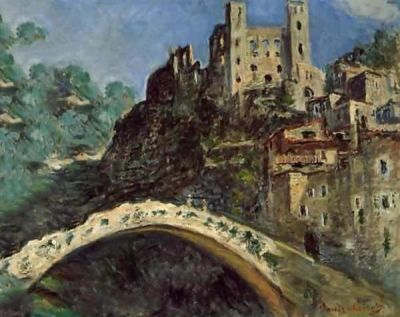Dolceacqua is a lovely village nestled in the hills of Val Nervia in the Liguria region and is one of the gems of the Italian Riviera, just minutes from the sea and the nearby French Riviera.
Claude Monet, who in 1884 stayed in nearby Bordighera, was enchanted by the village of Dolceacqua. The Impressionist Painter drew the view of the village, the Castle of the Roman bridge of Dolceacqua, and, fascinated, wrote: “… the place is superb, there is a bridge that is a jewel of lightness …”
Today, the medieval village of Dolceacqua is still identical to how Claude Monet painted it in the late 1800s. Because of its timeless beauty, Dolceacqua is now a destination for tourists of all nationalities, who visit from the coastal cities of Liguria and neighboring France or who spend a few days of vacation in the numerous bed & breakfasts.
Dolceacqua is the oldest Orange Flag in Italy. More than 100 villages in Italy have been awarded this coveted honor. The Orange Flag is a seal of excellence awarded to towns and villages that not only have a historical, cultural, and environmental heritage of merit, but are also renowned for offering tourists a quality welcome.
Dolceacqua is a typical medieval village of Val Nervia. The oldest part of the village, located at the foot of Monte Rebuffao, is dominated by the Doria Castle, and is called ‘Earth’ (Tera in local dialect) by the locals. The more modern portion of the village, called Borgo, developed during the 15th century. It stretches on the opposite shore. The two parts of Dolceacqua were connected by the characteristic donkey-back bridge that so amazed the Impressionist painter Claude Monet.
The first official document that sites Dolceacqua dates back to 1151, when the accounts of Ventimiglia had the first heart of the castle built at the top of the rocky cliff overlooking the creek where the valley tightens and forks: the Roja valley on one side, the Val Nervia on the other.
In 1270, Dolceacqua was purchased by the Doria of Genoa and for many centuries it was the capital of Doria’s rule. Throughout these times, the Grimaldi of Monaco, the Savoy and the Doria themselves fought for control of the village. Finally in 1746, the castle was besieged by the French and Spanish armies and almost destroyed. The Doria moved to the village in the same palace that, in 1794, hosted Napoleon Bonaparte.
Since then, the castle has undergone several transformations. Today, tourists will find military structures, service spaces, and prisons on the side facing the village, while on the other side – separated by a large courtyard – residential and government living quarters.
Not only is the village known for its architecture and history, but Dolceacqua’s red gold is its wine. The Rossese, arguably the most well-regarded red wine DOP/DOC in the province of Liguria, was appreciated by Pope Paul III who had his Roman cellars supplied, and by Napoleon.
Consider driving up the Nervia Valley to Dolceacqua, just minutes from the coastal towns of the west Italian Riviera, Bordighera and Ventimiglia.



